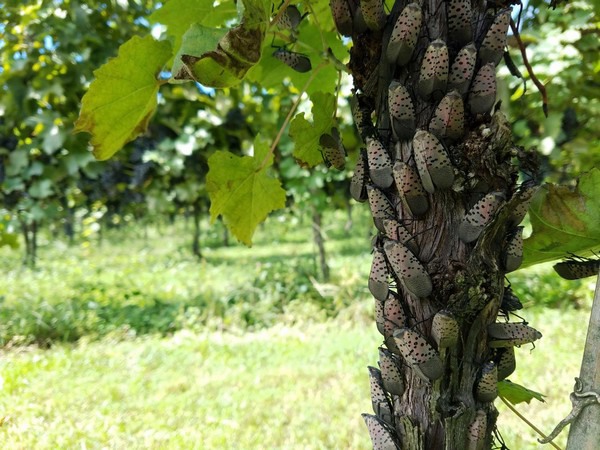Since the spotted lanternfly’s unwelcome arrival in Berks County, Pennsylvania, in 2014, researchers have been working tirelessly to learn more about the invasive pest, now confirmed in 45 Pennsylvania counties and reported in surrounding states.
Native to Asia, the spotted lanternfly was a new species in the United States, so there was little known about it at the time, said Julie Urban, research associate professor of entomology at Penn State.
“It’s a complex insect, and it takes a village to fully understand what we are seeing and how this can inform management,” said Urban about the pest, which feeds on the sap of fruit and landscape trees, grapevines, and woody ornamental plants. “We are making discoveries and are sharing those findings with the public and with government and industry stakeholders.”

Penn State is part of an interdisciplinary spotted lanternfly research group funded by the U.S. Department of Agriculture’s Specialty Crops Research Initiative. The group also includes the USDA Agricultural Research Service, USDA Animal, and Plant Health Inspection Service, Virginia Tech, the Northeastern IPM Center, the universities of Delaware and Rhode Island, and Temple, Rutgers, and Cornell universities.
Researchers are studying the pest’s flight behavior, where it might travel, and the conditions it needs to flourish, its feeding preferences, and the potential to disrupt the lanternfly female reproductive cycle. Scientists also are evaluating the effectiveness of biological control agents.
Educating the public about research discoveries falls to Penn State Extension educators, including Emelie Swackhamer and Amy Korman, who created a list of spotted lanternfly actualities, which they talk about during their presentations:
- Spotted lanternflies don’t bite people, and they aren’t aggressive, according to Swackhamer. “They do cause damage to plants and present a nuisance, so don’t adopt one for a pet,” she said. “It is widely recommended that they be dispatched upon sight.”
- The pest is not killing desirable landscape trees. Still, it will kill grapevines and trees of heaven, which is a rapidly growing deciduous tree native to East Asia and a widespread invasive species across North America. That noted, recent research led by Kelli Hoover, professor of entomology, has shown that heavy spotted lanternfly feeding has been shown to stunt the growth of saplings, including those of silver maple.
- Spotted lanternflies damage grapevines by sucking out nutrients, thus reducing the plant’s ability to make energy through photosynthesis and starving it of the starch typically stored in roots for survival through winter. While heavy infestations of spotted lanternflies on grapevines — especially in successive years — can result in their demise, most vines may be able to survive lighter infestations with few ill effects, per a recent study of the spotted lanternfly’s effect on grapevine biology, published by Penn State scientists.
- While the pest has not been shown to kill or damage stone fruit or nursery stock, it has created more work for commercial nurseries due to the inspections required to ensure that plants are free of spotted lanternflies before they are shipped.
- Contrary to initial alarm bells suggesting that spotted lanternflies were impervious to controls, insecticides — including “softer” products such as insecticidal soap — have been shown to be effective in controlling populations of the planthopper. A guide that details spotted lanternfly management techniques can be found on the Penn State Extension website.
- Spotted lanternfly population numbers fluctuate from year to year. Some residents living in regions with previously sizeable lanternfly populations have reported fewer lanternflies in recent years. These observations have led some to speculate that the insect interloper might be gone for good, but that is wishful thinking, according to Korman. “Several factors are affecting spotted lanternfly populations, including the impact of natural predators and parasites, people’s efforts to reduce populations, the natural ebb and flow of insect populations, and lack of food,” she said.
- Beneficial predators, such as praying mantis, spiders, wheel bugs, and birds, have the potential to offer biological control, and an ongoing study led by Hoover’s lab is investigating these predators’ impact on populations.
Pennsylvania regulatory measures require that businesses transporting materials must obtain a permit indicating employees have been trained on identification and removal and that items have been inspected and are free of spotted lanternflies.
Individuals can do their part to help stop the spread of the pest by inspecting items, especially those stored outside, before moving them and by destroying any egg masses and spotted lanternfly nymphs or adults upon discovery.
More information about identifying and controlling spotted lanternflies, reporting an infestation, and complying with quarantine regulations is available on the Penn State Extension spotted lanternfly website.
Source: psu.edu
